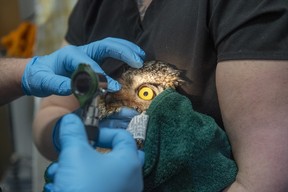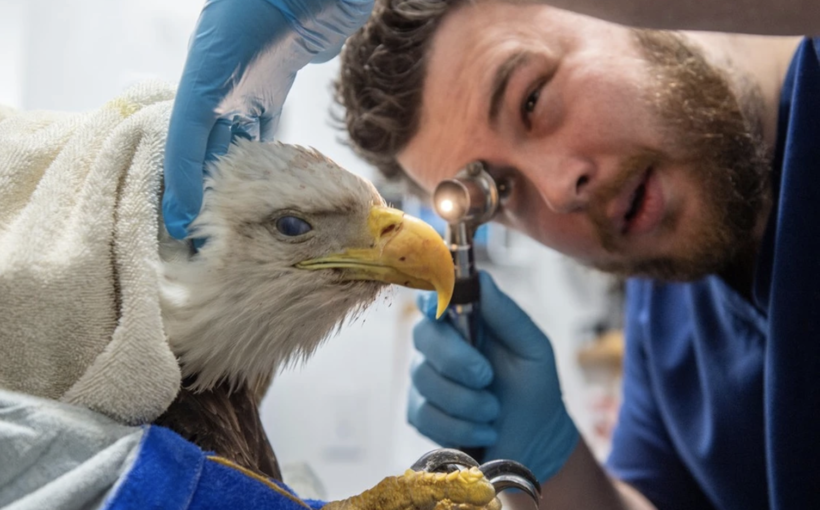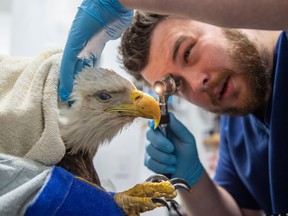A big brown bat with swollen wrists.
All in a morning’s work for Dr. Daren Mandrusiak, a veterinarian specializing in exotic animals.
At an Edmonton-based non-profit organization, the recent Monday morning’s sick parade is diverse. The patients are tiny and frequently dangerous by nature.
At WILDNorth’s Edmonton wildlife hospital, 12515 128 St., precautions must be taken against tooth and claw.
Don’t use lead shot
An unusually bedraggled bald eagle was lethargic — to the point of not seeming to mind being handled. Never a good sign.
His optic nerves were damaged — he didn’t respond even to a swipe of a hand near his striking yellow eyes.

A lead test revealed the raptor had likely been snacking on carrion that had been shot with lead ammunition.
“They eat carcasses from hunting, or from like euthanasia of a cow, and will often pick up a little bit of ammunition with pieces of meat,” Mandrusiak said.
Once the lead shot hits the acidic stomach, the bird develops lead toxicosis. The neurotoxin binds calcium in the nerves and causes globalized neurologic issues.
Staff cut up a plastic folder to attach to the tail of the eagle to protect feathers he’d need to fly again.
They put him on chelation therapy to leech the lead out, but the bird probably had brain damage, Mandrusiak said.
“It can leave some pretty substantial and long-lasting impacts,” he said, noting that lead shot is an issue for humans as well.
“In small portions, it can actually delay a child’s mental development. It’s a big issue.”
Big-hearted volunteer
Mandrusiak volunteers his time at WILDNorth, one of several animal causes he and the rest of the staff at southwest Edmonton’s Harvest Pointe Animal Hospital — where he’s a veterinarian to exotic pets — support.
A self-described “bird nerd,” he loves taking care of the wild creatures. At work, his bread-and-butter is tame exotics — cockatiels, boa constrictors, lop-eared rabbits, chinchillas.

“The only thing I don’t do is dogs and cats,” he said.
Many vets are reluctant to work on wild or exotic creatures, said Mandrusiak, who works to implement “fear free” avian techniques to decrease the stress of his feathered patients.
“It’s really an underserved community of animals,” he said.
Mandrusiak keeps a lookout for patients who, sick as they may be, seem to suffer a bit more for time spent in healing captivity and need to make their way back to the wild pronto.
Week by week, much of the news is good. The short-tailed stoat who ingested rat poison lived to feel much better, and to see her camouflage-friendly coat turn from the white ermine phase of winter to the stylish brown of spring.
The Edmonton wildlife hospital has a treatment room; on-site radiology and on-site surgery and short-term housing.
WILDNorth’s Parkland County Rehabilitation Centre offers flight pens, pools, and housing for long-term rehabilitation to take patients through the recovery process to release.
The hospital and rehabilitation centre are open seven days a week, 365 days a year, looked after by a dedicated cadre of staff and more than 200 volunteers.
Since 1989, WILDNorth — formerly the Wildlife Rehabilitation Society of Edmonton — has helped more than 40,000 birds and small mammals, drawing patients from as far away as the Northwest Territories and Saskatchewan.
Birds of a feather
Presiding over the Edmonton WILDNorth facility just off Yellowhead in North Edmonton, a big black dog named Fable is the resident greeter and most avid volunteer.
Quiet and unflappably friendly, Fable gazes with a measure of sympathy at visitors and animals alike, looming like a talisman in the doorway between lobby and hospital.
Fable knows better than to bark — or to follow her humans into the land of creatures tucked away in their temporary digs.
Adopted by executive director Dale Gienow, she spent her youth as a K9 ambassador for the Edmonton Humane Society.
The other ambassador is Corvy the raven. Saved in infancy by well-meaning animal lovers, he quickly learned to rely on humans.
It became clear Corvy was too habituated to be kindly released. When placed in an enclosure with two wild-raised baby ravens, he eschewed their skittish natures, happily hopping toward any human interloper as an expected source of food and companionship.

Corvy has taught himself a few words — not including “Nevermore!” — but repeats them on his own timetable only.
With gleaming black feathers and bright and curious corvid eyes, he’s a lively focal point on visits.
Owl in a day’s work
Within a sterile field of a few cubic feet, Mandrusiak and Carly Lynch, RVT, WILDNorth’s director of WildCare, worked to save the livelihood of a Great Horned owl whose right eye had deadened when he was struck by a car, likely when swooping in to snag some small mammalian snack.
Owls lead with their faces when they fly, and the iris was destroyed, the pupil deformed.
Saving the bird meant an ocular evisceration — removing the margins of the eyelids and scooping out the cornea, but leaving the shell of the eye in the skull so it could heal and fill up with tissue, as the owl’s prominent eyes
make up a significant weight in their skull.
“If we take all of that out, then he’ll sit (crooked) and then he’s not going to be able to hear properly because he’s not going to be straight,” Mandrusiak said.
“Owls are one of the few bird of prey species that can live with just one eye. They can be released because they hear so well — they hunt with their hearing a lot,” Mandrusiak said.

The Great Horned is one of the fluffiest of all owl species because they winter in the Alberta chill, so the gentlest way to find the skin for an injection is by blowing gently to part the down to the skin.
The trickiest part of the surgery was anesthesia. A wild patient can’t itemize any other underlying conditions — issues with cardiovascular or organ problems.
The owl’s heart rate was 180, boding well.
The owl went off to rehab to heal. He has a permanent wink, of course, and now he has to learn to keep (one) eye out for prey while hunting to get back on his game, so to speak.
“We expect a full recovery at this point and, assuming he rehabilitates well, a release,” Mandrusiak said.




